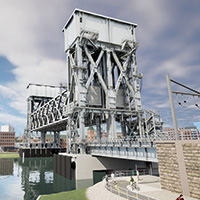The bridge should have been shored up and the road under it closed following the discovery of growing cracks in the structure, says the report by the USA's Occupational Safety & Health Administration (OSHA).
One employee and five motorists were killed in the accident, which happened in the early afternoon of 15 March 2018 (link opens in new tab). A further employee was permanently disabled. At the time of the collapse, the bridge consisted of a single concrete truss spanning approximately 53m and weighing approximately 930t. It had been placed on its piers just five days prior to the collapse.
The 115-page report, which has been prepared by the director of OSHA's Office of Engineering Services (OES), Mohammad Ayub, reaches 12 conclusions, summarised here:
- It says that Figg Bridge Engineers, the Engineer of Record (EOR), failed to recognise that the bridge was in danger of collapsing when it inspected it hours before the collapse. The concrete truss had developed numerous wide and deep structural cracks jeopardising the integrity of the bridge. The EOR should have immediately instructed that the bridge be shored at appropriate locations and SW 8th Street be closed, says the report. At the time of collapse, the post-tensioning bars were being re-tensioned at the specific instructions of the EOR.
- The bridge had structural design deficiencies that contributed to the collapse during the third stage of the construction stage. The cracks on the bridge occurred due to deficient structural design, says the report.
- The EOR held a meeting with project participants after evaluating the cracks over the course of the previous two days. At that meeting, OSHA says that the EOR acknowledged that his computations could not replicate the cracks and therefore he did not know why the cracks were occurring. The Construction Engineer & Inspector (CEI) of the project advised the EOR at this meeting that the cracks were lengthening daily. Despite these admissions and the knowledge that the cracks were growing in size, EOR stated more than once that the cracks did not present any safety concerns.
- The report says that the magnitude of the cracks warranted that SW 8th Street be immediately closed, and the concrete truss be shored and supported at multiple intermediate locations to reduce the loads in the north diagonal and the node until final evaluations were done and remedial measures implemented.
- Networking Engineering Services, Inc, doing business as Bolton Perez & Associates, Inc (BPA) was retained by FIU to be the CEI of the project. The report says that BPA failed to classify the cracks in accordance with the Florida Department of Transportation (FDOT) and that it failed to recognise that the bridge was in danger of collapsing, and did not recommend closure of the street and shoring the bridge, regardless of the opinion held by the EOR.
- Munilla Construction Management, Inc (MCM), the design-build contractor, failed to correct a statement by the EOR saying that MCM had that said that the cracks had not grown since 10 March. Despite this oversight on the part of MCM, the EOR was provided with photographs and measurements of the cracks in the days leading up to the collapse and was specifically informed by BPA during the morning meeting on 15 March that the cracks were lengthening.
- The report says that MCM, the design-build contractor, deferred to the decision of EOR and failed to exercise its own independent professional judgement, as a constructor of the bridge, to close the traffic on SW 8th Street. The report says that MCM’s deference to the EOR and failure to exercise its own independent judgment with regard to implementing necessary safety measures were unreasonable.
- The evaluations of the cracks by the EOR, and his recommendation to re-tension the post-tensioning bars of diagonal 11, were not included in the original design and therefore should have been subject to peer review.
- The consultant retained by the EOR to conduct independent peer review of the EOR’s design, as per FDOT requirements, did not check the structural integrity of the bridge under different construction stages, a violation of the FDOT requirements.
- The EOR failed to provide construction documents to Louis Berger at 30%, 60% and 90% of completion of construction documents, in accordance with the FDOT requirements.
- The EOR should have known that the consultant who conducted the peer review did not check the structural design of the truss design at stage III, as required by FDOT, meriting extra safety precautions by EOR.
- The EOR should have known that the truss was a non-redundant structure and if one diagonal member failed, the entire bridge could collapse. Given the nature and extent of the cracking and the non-redundancy of the bridge design, necessary safety precautions should have included closing the roadway below the bridge and immediately providing shoring to the bridge at suitable locations until a complete evaluation was done.
A separate investigation by the National Transportation Safety Board is also under way.




